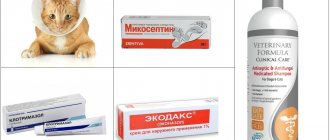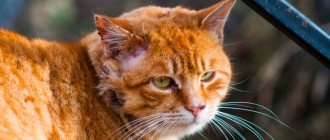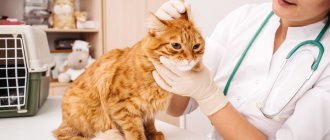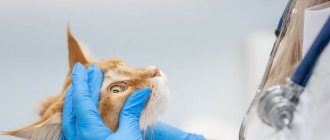Cats, like people, often suffer from various infections, viruses and diseases. Moreover, often illnesses concern the eyes, which can be considered the most vulnerable organ that requires special care. Sometimes eye diseases occur due to mechanical damage, chemicals or viruses. The most common eye diseases in cats are glaucoma, conjunctivitis or inflammation of the lacrimal sac; a little less often the cause is hepatitis, plague, and oncology. It is very difficult to independently determine the cause and disease, so when the first symptoms appear, it is recommended to immediately consult a doctor. How to treat a cat’s eyes, what are the first signs of disease and what should you pay attention to? Let's tell you more!
The main causes of eye diseases in cats
The cause of eye disease in cats can be determined by the type of discharge:
- Watery discharge without impurities is caused by allergies, mechanical damage or shock;
- Discharge in the form of a gel indicates a protective reaction to infection or irritation;
- Discharge of a yellowish, greenish tint indicates a bacterial infection with a purulent lesion;
- Dried spots on the floor of the eyes are often observed in cats with a flat face and indicate blocked ducts.
Despite the fact that cats have a third eyelid that performs protective functions, it is impossible to completely avoid eye diseases.
Trust your cat's health to veterinarians
And safety is for cat sitters. There is a professional for every occasion!
learn about cat nanny
What to do if the cat closed one eye?
First aid
With such symptoms, there is no way to do without a veterinary examination.
Therapy for the condition in which kittens or older cats squint their visual organ is based on stopping the factor that caused the problem. If the owner notices this unpleasant symptom in a pet, the first thing he needs to do is take the animal to a veterinary clinic. The doctor will conduct the required examinations that will reveal the root cause.
If there is no opportunity to quickly deliver the cat to the clinic, the owner will need to independently examine the visual organ that the pet is squinting. It is important to make sure that there are no foreign objects in it. Then you should carefully rinse the cat's eyes with boiled water at room temperature or saline solution. You need to moisten gauze in the liquid and carefully wipe the cat’s eyelids.
It is forbidden to use cotton swabs, since the cotton wool can stick to the fur and then get on the cornea, worsening the pet’s condition. In addition, you will need to stop using antiseptic solutions. These medications can cause a corneal burn. If the problem is accompanied by purulent discharge, it is important to clean the eyes as carefully as possible. A person will need to move from the outer corner to the inner one.
Drug therapy
Certain ailments can be eliminated with the help of drops.
After providing first aid to your pet, a visit to the veterinarian should still take place. After carrying out diagnostic measures, the veterinarian will be able to select the correct treatment regimen. For example, if a cat squints its eye due to the development of conjunctivitis, he is prescribed antibacterial medications. They can be prescribed either in the form of eye drops or in the form of ointments.
When the problem is accompanied by pain, the cat is given painkillers. They often resort to the help of Novocaine, which will need to be instilled twice a day under the lower eyelid of the affected visual organ. If squinting of the eyes is caused by allergic reactions, therapy consists of identifying the allergen and avoiding contact with it. Sometimes pets are prescribed corticosteroids. However, these medications have a number of serious side effects, so they are used in advanced situations.
Mycoplasmosis
One of the common eye diseases in cats is mycoplasmosis, which is understood as an infectious, bilateral lesion of the eye. The disease is characterized by the appearance of conjunctivitis with severe redness of the entire conjunctiva, including the third eyelid. Main signs of the disease:
- Various types of discharge from the eyes;
- Redness of the eyes;
- Sneezing, coughing with discharge.
If both eyes of a cat become inflamed at once, we can talk about an infection. If only one eye is affected, we are talking about a non-contagious form of conjunctivitis. Usually mycoplasmosis goes away on its own within 10-14 days, otherwise it can become chronic. Moreover, the animal’s joints are affected, it begins to limp, it is difficult for it to carry out even simple movements, and at the same time its body temperature rises. The course of treatment must be prescribed by a doctor; antibiotics and special drops are usually used.
Keratitis
Keratitis is inflammation of the cornea.
Cause. Keratitis in cats is caused by infectious diseases (infectious rhinotracheitis in cats, feline chlamydia, mycoplasmosis in cats, calicivirus infection of cats), helminthic infestations, damage to the cornea by a foreign body, and eye injuries. Often the cause of keratitis can be inflammatory processes in nearby tissues.
Clinic. Keratitis in a cat can be superficial, deep and ulcerative. With keratitis, a cat may experience vision loss. During a clinical examination of a sick animal, a veterinarian notes redness of the eye, photophobia, clouding of the cornea, pain, and visible blood vessels. Cloudiness of the cornea occurs due to cellular infiltration (by leukocytes) and changes associated with cell swelling, their degenerative decay, as well as changes in the intercellular connective tissue. The intensity of turbidity can be different and depends on the density and nature of the infiltrate or edema in the interstitial tissue. The gray-smoky color of the cloudiness is formed by a small accumulation of leukocytes. With an increase in the number of leukocytes, the color of the cornea becomes white; a yellowish tint characterizes a purulent infiltrate. The opacification may be diffuse or limited to isolated areas in the form of dots or spots in the anterior layers (superficial keratitis) in the parenchyma (parenchymal keratitis). If the surface layers are damaged, the cornea loses its specular properties and becomes matte. With keratitis, vascularization of the cornea also occurs (ingrowth of blood vessels into the cornea). At the same time, during a clinical examination, the veterinarian notes a pericorneal injection, which is characterized by overflow of densely located vessels in the limbus area. The reaction from the conjunctiva, mainly its scleral part, is manifested by edema and hyperemia. With keratitis, experts note a reaction from the iris. The membrane becomes hyperemic, the pupil narrows, and serous, fibrinous or purulent exudate sometimes appears in the anterior chamber. With acute keratitis, a cat experiences photophobia, spasm of the eyelids, lacrimation and pain. In eosinophilic keratitis, veterinarians upon clinical examination detect the presence of white plaques on the cornea that extend from behind to the anterior wall. Slight lacrimation is noted. When performing a cytological examination, we find a large number of eosinophils.
Treatment. Symptomatic treatment is carried out. Eliminate the underlying disease that caused the keratitis. The affected eye is washed with antimicrobial solutions, and eye ointments and drops are used. If a purulent process occurs, antibiotics are used; for deep and ulcerative keratitis, eye microsurgery is used. For eosinophilic keratitis, they resort to the use of immunomodulators and hormones.
Symblepharon
Another eye disease in cats is symblepharon, which is characterized by fusion of the conjunctiva with the eyelid and cornea. This disease may differ in the area affected. If the disease affects a large part, then this is a serious defect that impairs vision, although it does not cause any discomfort in the pet. With partial symblepharon, when fusion with the cornea does not occur, the prognosis is quite favorable. As for treatment, several techniques are used here:
- Sanitation of eyes every day;
- Separation of the conjunctiva from the cornea using local medications with antibiotics and anti-inflammatory drugs;
- If the eye damage is serious, surgery may be prescribed.
Uevit
Uevitis is an inflammation of the choroid of the eye.
Cause. Uevitis in cats occurs as a result of eye injuries, metabolic disorders, eye tumors, autoimmune diseases, toxoplasmosis, rickettsiosis, diseases caused by viruses (feline leukemia, feline immunodeficiency, infectious peritonitis, etc.).
Clinic. Uevitis in a cat is accompanied by photophobia, lacrimation, eye pain, blepharospasm, strabismus, the cat's pupil is greatly reduced or takes on an uneven, blurry shape. The eyes have a red and cloudy appearance on clinical examination. There is a change in the color of the iris.
Treatment of ueviitis in a cat should be aimed at the cause that led to the disease. Eye drops are instilled into the eyes and painkillers are prescribed. Antibiotics and other antimicrobial drugs are used. If there is a threat of developing glaucoma, it is necessary to resort to surgical removal of the diseased eye.
Obstruction of the lacrimal duct
Tears must flow through a special channel that is located inside the nose, but if the outflow path is disrupted, the tears come out through the eyes. The main symptom is different types of lacrimation and the appearance of brown fur around the eyes (tear tracks). A similar problem can be congenital (found in some breeds - Sphynx, Persian or Scottish cats) or acquired (obstruction can be caused by various infections).
If patency occurs due to blockage or fusion of the nasolacrimal duct, surgical intervention may be prescribed. Although the use of special rinses and preparations is usually sufficient.
Corneal ulcer
An ulcer is a disease in which inflammation of the cornea and its defect are observed. Among the main signs:
- Squinting;
- Soreness;
- Various types of discharge;
- A dimple, roughness, or white spot may appear on the cornea.
Treatment depends on the severity of the form: sometimes taking antibiotics is enough, and sometimes surgery is prescribed.
Turn of the century
Cats sometimes suffer from a condition called entropion, where the eyelid turns inward, causing injury to the cornea and conjunctiva. Among the causes of the problem are birth defects and complications after operations. If we talk about the signs of the disease:
- Narrowing of the palpebral fissure;
- Cloudiness of the cornea;
- Constant lacrimation;
- Keratitis;
- Conjunctivitis.
There is only one possible treatment option available - surgery.
Classification
There are several of them. By type of process there are:
- Inflammatory. These include conjunctivitis, keratitis, keratoconjunctivitis, iritis (the iris is damaged), inflammation of the lacrimal canal, etc.
- Not inflammatory. Injuries, bruises, foreign bodies entering the eye, entropion of the eyelids, cataracts, glaucoma, etc.
According to the course of the process, the disease can be acute, subacute and chronic. In the subacute process, the symptoms do not disappear completely, but only subside slightly, while the danger of vision deterioration remains. This course is no less dangerous than acute or chronic, although it seems that the animal has gotten better.
They are divided into:
- Primary – eye problem – this is the underlying disease.
- Secondary - the organ of vision reacted in response to concomitant pathology. For example, when a cat is infected with bacteria, in addition to other organs, the eyes are also affected, which manifests itself in the form of conjunctivitis. In this case, it is necessary to identify the disease that caused this condition and treat the animal comprehensively, and not just deal with the symptoms.
Glaucoma
One of the most dangerous eyes in cats is glaucoma, which is characterized by increased intraocular pressure and an increase in the size of the eyeball. The disease can be primary or secondary. In 80% of cases, the primary form occurs, and the secondary form occurs less frequently and is due to damage to the lens or due to uveitis. The main symptoms are swelling of the eyelid, squinting, dilated pupils and increased tear production. In addition, the pupil stops responding to light or special medications. As for treatment, it is prescribed only after examination and only by a veterinarian.
Iritis (iridocyclitis)
Iritis (iridocyclitis) is inflammation of the iris and ciliary body.
Cause. Traumatic injury, inflammation spreading from the cornea, complications after eye surgery, infectious diseases.
Clinic. During a clinical examination, a clinic veterinarian notes a constriction of the pupil, dimming of the iris, photophobia, pain, and cloudy fluid in the anterior chamber of a sick cat. When conjunctivitis is associated with the disease, we note serous-purulent discharge.
Treatment. In order to restore pupil contraction, a 1% atropine solution, novocaine blockade, and antibiotics are prescribed. During treatment, eye drops and ointments with anti-inflammatory and antimicrobial effects have a good effect.
Cataract
There are some congenital eye diseases in cats, such as cataracts, which develop in old age. In this case, the lens loses its transparency and becomes cloudy. The main cause of the disease is a lack of water in the lens and cholesterol deposition.
Among the main signs of cataracts:
- Cloudiness of the eyes, the appearance of a gray-blue tint;
- If the damage is severe, the lens may become completely white with a yellow tint.
Treatment for this disease at home is not provided; a special operation is often prescribed.
Don't forget that there are dozens of infections, plus your pet can hit his eye, damage it, or suffer from exposure to chemicals and allergens.
Basic treatment recommendations
The main thing is to remember the basic principles of treating eye diseases and infections in cats:
- To reduce irritation, it is recommended to rinse the eyes with a cotton swab dipped in warm water, and remove crusts and pus;
- If the eyelid is affected, streptomycin ointment can be used;
- When treating, you should not use medications intended for humans;
- Before using herbal decoctions and tinctures in treatment, you must obtain a doctor's permission;
- You need to start treatment only after making a diagnosis and determining the cause of the disease.
Sore eyes of cats can almost always be cured, the main thing is not to delay, immediately contact a veterinarian and follow all recommendations.
Blepharitis
Blepharitis is inflammation of the eyelids.
Cause. Traumatic damage to the eyelids, the presence of a bacterial or fungal infection, allergies in animals, diabetes (diabetes mellitus in animals, diabetes insipidus in animals), liver disease.
Clinical signs. During a clinical examination, a veterinarian notes redness of the eyelids, swelling, photophobia, profuse lacrimation, itching and burning in the area of inflammation of the eyelids, loss of hair and eyelashes around the eyelids.
Treatment of blepharitis should be aimed at eliminating the cause that led to blepharitis. The sore eye is washed with a decoction of calendula or chamomile, a solution of boric acid, potassium permanganate or furacillin. Eye drops are instilled into the conjunctival sac. If infection is present, antibiotics are used.











